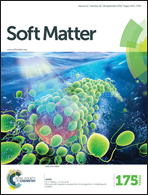Amoeboid swimming in a channel
Abstract
Several micro-organisms, such as bacteria, algae, or spermatozoa, use flagellar or ciliary activity to swim in a fluid, while many other micro-organisms instead use ample shape deformation, described as amoeboid, to propel themselves either by crawling on a substrate or swimming. Many eukaryotic cells were believed to require an underlying substratum to migrate (crawl) by using membrane deformation (like blebbing or generation of lamellipodia) but there is now increasing evidence that a large variety of cells (including those of the immune system) can migrate without the assistance of focal adhesion, allowing them to swim as efficiently as they can crawl. This paper details the analysis of amoeboid swimming in a confined fluid by modeling the swimmer as an inextensible membrane deploying local active forces (with zero total force and torque). The swimmer displays a rich behavior: it may settle into a straight trajectory in the channel or navigate from one wall to the other depending on its confinement. The nature of the swimmer is also found to be affected by confinement: the swimmer can behave, on average over one swimming cycle, as a pusher at low confinement, and becomes a puller at higher confinement, or vice versa. The swimmer's nature is thus not an intrinsic property. The scaling of the swimmer velocity V with the force amplitude A is analyzed in detail showing that at small enough A, V ∼ A2/η2 (where η is the viscosity of the ambient fluid), whereas at large enough A, V is independent of the force and is determined solely by the stroke cycle frequency and the swimmer size. This finding starkly contrasts with models where motion is based on ciliary and flagellar activity, where V ∼ A/η. To conclude, two definitions of efficiency as put forward in the literature are analyzed with distinct outcomes. We find that one type of efficiency has an optimum as a function of confinement while the other does not. Future perspectives are outlined.


 Please wait while we load your content...
Please wait while we load your content...